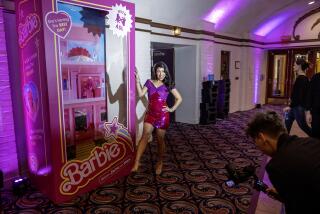Success Is at Hand
- Share via
For the blind, the numbers are impossible to ignore.
The unemployment rate for blind or visually impaired people who can’t read Braille reaches 75%.
For those who read Braille, the rate drops to 20%, said John Zamora, coordinator of youth and career services at the Anaheim-based Braille Institute.
Under the weight of those numbers, more than 70 blind or visually impaired children flocked to the institute from across Southern California on Saturday for the first “Braille Challenge”--an academic competition that incorporated reading comprehension, spelling, proofreading and transcribing.
Zamora said he hopes to make the challenge an annual event.
“More than ever, we are realizing the importance of Braille skills and Braille reading in the education of blind students,” he said. “It’s critical.”
It’s a lesson 10-year-old Jason Gross, who was born blind, has taken to heart.
Jason, who wants to be either a psychologist or a psychiatrist, was competing against junior high and high school kids on Saturday.
He reads “Grade 2” Braille, which incorporates contractions and other shorthand, and has skipped a grade in school.
Jason is already reading the wildly popular “Harry Potter” series.
He’s in the minority--just 10% of blind people understand Braille.
“He started learning in preschool,” said his mother, Cathy Gross, a Clairemont resident.
“It would be the same as if you or I grew up and didn’t know how to read,” she said.
“We wouldn’t have a very good chance of getting a job, and they won’t either. If you can’t read, whether you have vision or not, it’s a problem.”
*
By most accounts, the children enjoyed the competition, but for some it was a high-stress experience--no different than the atmosphere during a standard spelling bee.
In one room of the Braille Institute’s campus, competitors strapped on headphones and transcribed taped stories into Braille. Parents were not allowed inside.
In another room, they found Braille words in a crossword-like “scramble,” which was made even more challenging because the dots that form letters did not have any space between them.
Others were being judged on their comprehension of stories, such as one about the Iditarod Trail Sled Dog Race.
The stories were written in Braille, a code of raised dots that are read by scanning them with a fingertip.
*
The system was invented in 1824 by Louis Braille, a 15-year-old French student who was rendered blind by an infection.
A brain tumor left Demetrius Lee blind in his left eye and partially blind in his right eye.
He’s 17 now, still learning to live as a blind person, still appreciating the doors that Braille is opening for him.
Demetrius, who is home-schooled in Moreno Valley and wants to be either a scientist or a lawyer, chatted with other blind students, flashing an infectious smile.
He said Saturday’s competition left him more confident than ever.
“I learned some things today about other blind people,” he said. “I learned that blind people can do a lot of things--anything they want to do.”
The faster blind students learn Braille, the faster they can move on to other pursuits, said Jessica Callahan, 14, one of the competitors and an eighth-grader from Lakewood.
Because she learned to read and write so quickly, Jessica has taken on advanced Braille reading--using it, for example, to learn Spanish and to read music.
“It allows you to do so many things,” she said. “It just makes your intelligence soar.”
More to Read
Sign up for Essential California
The most important California stories and recommendations in your inbox every morning.
You may occasionally receive promotional content from the Los Angeles Times.














